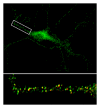Multiple approaches to investigate the transport and activity-dependent release of BDNF and their application in neurogenetic disorders
- PMID: 22720171
- PMCID: PMC3375105
- DOI: 10.1155/2012/203734
Multiple approaches to investigate the transport and activity-dependent release of BDNF and their application in neurogenetic disorders
Abstract
Studies utilizing genetic and pharmacological manipulations in rodent models and neuronal cultures have revealed myriad roles of brain-derived neurotrophic factor (BDNF). Currently, this knowledge of BDNF function is being translated into improvement strategies for several debilitating neurological disorders in which BDNF abnormalities play a prominent role. Common among the BDNF-related disorders are irregular trafficking and release of mature BDNF (mBDNF) and/or its prodomain predecessor, proBDNF. Thus, investigating the conditions required for proper trafficking and release of BDNF is an essential step toward understanding and potentially improving these neurological disorders. This paper will provide examples of disorders related to BDNF release and serve as a review of the techniques being used to study the trafficking and release of BDNF.
Figures





Similar articles
-
Development of mature BDNF-specific sandwich ELISA.J Neurochem. 2015 Jul;134(1):75-85. doi: 10.1111/jnc.13108. Epub 2015 Apr 21. J Neurochem. 2015. PMID: 25824396
-
Brain Derived Neurotrophic Factor: a novel neurotrophin involved in psychiatric and neurological disorders.Pharmacol Ther. 2012 Apr;134(1):116-24. doi: 10.1016/j.pharmthera.2012.01.006. Epub 2012 Jan 20. Pharmacol Ther. 2012. PMID: 22281237 Review.
-
Neuronal brain-derived neurotrophic factor is synthesized in excess, with levels regulated by sortilin-mediated trafficking and lysosomal degradation.J Biol Chem. 2011 Aug 26;286(34):29556-67. doi: 10.1074/jbc.M111.219675. Epub 2011 Jul 5. J Biol Chem. 2011. PMID: 21730062 Free PMC article.
-
New insights in the biology of BDNF synthesis and release: implications in CNS function.J Neurosci. 2009 Oct 14;29(41):12764-7. doi: 10.1523/JNEUROSCI.3566-09.2009. J Neurosci. 2009. PMID: 19828787 Free PMC article. Review.
-
Analysis of blood mature BDNF and proBDNF in mood disorders with specific ELISA assays.J Psychiatr Res. 2021 Jan;133:166-173. doi: 10.1016/j.jpsychires.2020.12.021. Epub 2020 Dec 13. J Psychiatr Res. 2021. PMID: 33341455
Cited by
-
A small-molecule TrkB ligand improves dendritic spine phenotypes and atypical behaviors in female Rett syndrome mice.Dis Model Mech. 2024 Jun 1;17(6):dmm050612. doi: 10.1242/dmm.050612. Epub 2024 May 24. Dis Model Mech. 2024. PMID: 38785269 Free PMC article.
-
The BDNF val-66-met Polymorphism Affects Neuronal Morphology and Synaptic Transmission in Cultured Hippocampal Neurons from Rett Syndrome Mice.Front Cell Neurosci. 2017 Jul 13;11:203. doi: 10.3389/fncel.2017.00203. eCollection 2017. Front Cell Neurosci. 2017. PMID: 28751857 Free PMC article.
-
The acute effects of aerobic exercise on sensorimotor adaptation in chronic stroke.Restor Neurol Neurosci. 2021;39(5):367-377. doi: 10.3233/RNN-211175. Restor Neurol Neurosci. 2021. PMID: 34569981 Free PMC article.
-
The Effect of Aerobic Exercise on Brain-Derived Neurotrophic Factor in People with Neurological Disorders: A Systematic Review and Meta-Analysis.Neural Plast. 2017;2017:4716197. doi: 10.1155/2017/4716197. Epub 2017 Sep 19. Neural Plast. 2017. PMID: 29057125 Free PMC article.
-
Decreased BDNF Release in Cortical Neurons of a Knock-in Mouse Model of Huntington's Disease.Sci Rep. 2018 Nov 19;8(1):16976. doi: 10.1038/s41598-018-34883-w. Sci Rep. 2018. PMID: 30451892 Free PMC article.
References
-
- Lu B, Pang PT, Woo NH. The yin and yang of neurotrophin action. Nature Reviews Neuroscience. 2005;6(8):603–614. - PubMed
-
- Lessmann V, Gottmann K, Malcangio M. Neurotrophin secretion: current facts and future prospects. Progress in Neurobiology. 2003;69(5):341–374. - PubMed
-
- Fahnestock M, Garzon D, Holsinger RMD, Michalski B. Neurotrophic factors and Alzheimer’s disease: are we focusing on the wrong molecule? Journal of Neural Transmission. Supplementum. 2002;(62):241–252. - PubMed
Publication types
MeSH terms
Substances
Grants and funding
LinkOut - more resources
Full Text Sources
Medical

